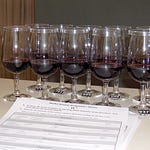This is the weekly newspaper column.
The case for swirling 5-25-2022
The classic formula for wine tasting is the “five Ss.” See. Swirl. Sniff/smell. Sip. Savor. Let’s explore swirl.
Swirling encourages aeration. When you expose wine to oxygen, aroma compounds attach themselves to evaporating alcohol and present you more aroma to experience and enjoy. The majority of tasting pleasure comes from aroma, not your taste buds, so this element is no small thing.
Oxygen also helps soften harsh tannins, making them smoother and silkier. Swirling is particularly beneficial for younger, bolder red wines. In contrast, an older wine needs a very gentle swirl or it can become over-oxidized and lose life. One technique does not fit all in the wine swirl world.
Oxygen induced by swirling can blow off unwanted aromas. Sulfites—occurring naturally during fermentation or added to stabilize the wine—can add a smell of rotten eggs or burnt match after some bottle age. Some wines, Burgundian pinot noir, for instance, can have barnyard odors upon first pour. Not to worry. Swirling almost always will waft away these issues.
Swirling benefits the “see” element of the five Ss. Your wine may appear lighter after a few swirls, allowing you to have a sight experience beyond “deep ruby.”
This being wine, there is a correct way to swirl. The bigger the glass, the more effective the swirl. Keep the base of the glass on the table and start slowly. Don’t overdo it. A few swirls, a minute or less, will do the trick. Continued swirling is not needed unless you have a difficult wine with particularly assertive tannins or obnoxious odors. Once swirled at the beginning of your tasting experience, the wine will continue to breathe and develop in the glass all by itself. Then it is time to indulge in the other four Ss.
Tasting notes:
• Primus The Blend, Apalta, Colchagua Valley 2018: Polished, fresh, fruity. Blend led by cab accompanied by carménère and a cadre of other reds. $18-20 Link to my review
• Duca Di Salaparuta Suor Marchesa Passo delle Mule Nero d’Avola 2018: Good, affordable, easy-drinking presentation of Sicily’s most famous black grape. $19-25 Link to my review
• Stoneledge Winery & Vineyard Malbec, Texas 2018: Hedonistic delight of ripe dark fruit running rampant in your mouth, pleasuring your palate. If you want to tussle with bodacious Texas wine, well here is your pour, partner. $50 Link to my review
Last round: What do you call a priest who becomes a lawyer? A father-in-law. Wine time.
Email: wine@cwadv.com
Newsletter: gusclemens.substack.com
Website: gusclemensonwine.com
Facebook: Gus Clemens on Wine facebook.com/GusClemensOnWine/posts/
Twitter: @gusclemens
Links worth exploring
Diary of a Serial Hostess is a weekly column about the ins and outs of entertaining at home and witty anecdotes of life in the stylish lane. How-to's and advice from yours truly, the Serial Hostess.
As We Eat is a multi-platform storytelling project exploring how food connects, defines, and inspires.
Balanced Diet by Charlotte Rutledge is a rotating selection of original recipes, curated links pertaining to the food system, and recipe reviews.
















The case for swirling 5-25-2022